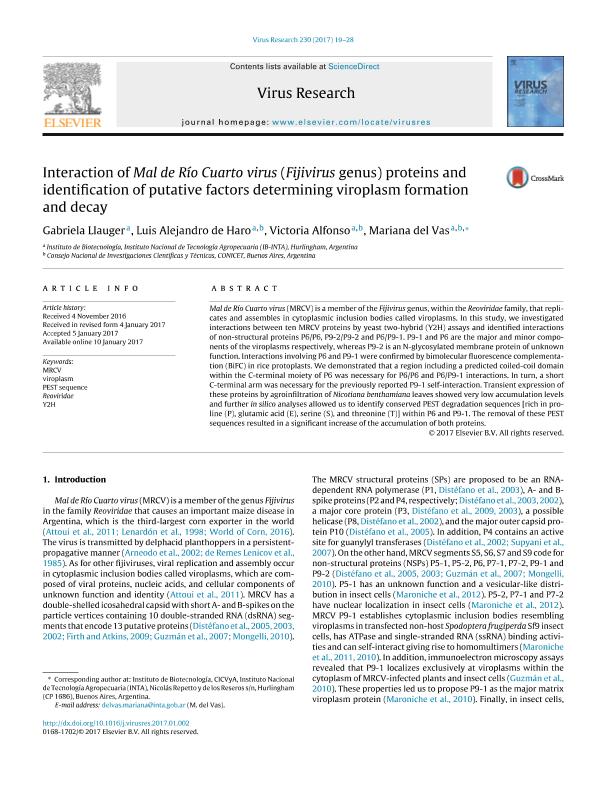Artículo
Interaction of Mal de Río Cuarto virus (Fijivirus genus) proteins and identification of putative factors determining viroplasm formation and decay
Fecha de publicación:
02/2017
Editorial:
Elsevier Science
Revista:
Virus Research
ISSN:
0168-1702
Idioma:
Inglés
Tipo de recurso:
Artículo publicado
Clasificación temática:
Resumen
Mal de Río Cuarto virus (MRCV) is a member of the Fijivirus genus, within the Reoviridae family, that replicates and assembles in cytoplasmic inclusion bodies called viroplasms. In this study, we investigated interactions between ten MRCV proteins by yeast two-hybrid (Y2H) assays and identified interactions of non-structural proteins P6/P6, P9-2/P9-2 and P6/P9-1. P9-1 and P6 are the major and minor components of the viroplasms respectively, whereas P9-2 is an N-glycosylated membrane protein of unknown function. Interactions involving P6 and P9-1 were confirmed by bimolecular fluorescence complementation (BiFC) in rice protoplasts. We demonstrated that a region including a predicted coiled-coil domain within the C-terminal moiety of P6 was necessary for P6/P6 and P6/P9-1 interactions. In turn, a short C-terminal arm was necessary for the previously reported P9-1 self-interaction. Transient expression of these proteins by agroinfiltration of Nicotiana benthamiana leaves showed very low accumulation levels and further in silico analyses allowed us to identify conserved PEST degradation sequences [rich in proline (P), glutamic acid (E), serine (S), and threonine (T)] within P6 and P9-1. The removal of these PEST sequences resulted in a significant increase of the accumulation of both proteins.
Palabras clave:
Mrcv
,
Pest Sequence
,
Reoviridae
,
Viroplasm
,
Y2h
Archivos asociados
Licencia
Identificadores
Colecciones
Articulos(SEDE CENTRAL)
Articulos de SEDE CENTRAL
Articulos de SEDE CENTRAL
Citación
Llauger, Gabriela; de Haro, Luis Alejandro; Alfonso, Victoria; del Vas, Mariana; Interaction of Mal de Río Cuarto virus (Fijivirus genus) proteins and identification of putative factors determining viroplasm formation and decay; Elsevier Science; Virus Research; 230; 2-2017; 19-28
Compartir
Altmétricas




